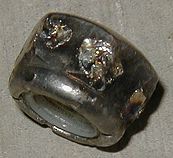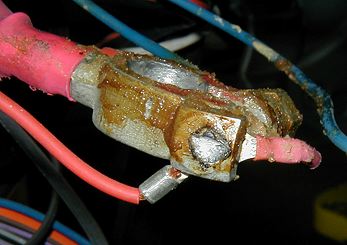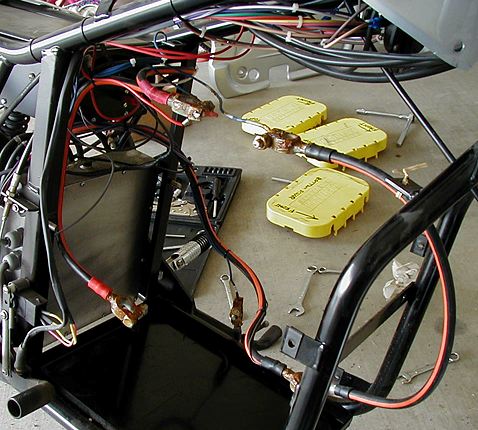February 2001: All Batteries Replaced
After the leaking battery incident, I still seemed to have normal range and power. As I’ve mentioned before, I only have a 6 mile run to work, and I get to recharge at work. So of course I had not actually stressed the Lectra to its full expected range in some time.
However, one night recently I forgot to plug my Lectra in at night. The next morning I had to get to work on half a charge. Since I have at a minimum a 12-mile range, I figured I was OK; I’d plug in at work. To my distress, the Lectra seriously began to lose power about a mile from work, and by the time I got there, Reserve had kicked in. Worse yet, it wasn’t the normal steady Reserve light, but a frantically blinking one. I limped in to work at about 20 mph and plugged in.
Eight hours later, expecting to see the Lectra recovered, I saw to my great distress that only 3 of the 5 SOC lights were lit, and the charger was still panting, with the “FAST CHARGE” light lit. Augh! Clearly, that last run had damaged the battery pack somehow.
I tried to get home on the 3 lights. Before I had gone even a quarter mile, one light extinguished. Not wishing to push my luck, I returned to the outlet at work and got another ride home, hoping that an overnight charge might put things to rights.
It didn’t. The next a.m. only 3 lights were lit, the “FAST CHARGE” light was still on, and the “OVER TEMPERATURE” light was blinking frantically. Sigh.
Turns out that a store called “Batteries Plus”, only a mile away, stocks the Optima Yellow Top batteries. I bought one, and installed it in place of the leaky one. Using my own charger (not the onboard one), which sports an ammeter, I checked the capacity of the leaky one. Dead, 0% ability to hold charge. I figured.
With the new one in, the Lectra’s onboard charger was able to light up all 5 SOC lights in a couple of hours. Delighted, I let it trickle-charge overnight and went for a spin on the next morning.
Not good. Each SOC light was only lasting 2 miles, not the 3.3 or 3.2 that they normally do. The power was low, too: I could only reach 40 mph, not 50. Worst of all, after 2 lights extinguished, the “flashing reserve” lights suddenly went on. I limped home, and went the last quarter mile with NO SOC LIGHTS lit at all. Augh!
I resigned myself to the considerable expense of 3 more brand-new Optima Yellow-Top batteries. Below is a picture of my Lectra without any batteries in it, followed by a picture of my extremely expensive battery collection:


Each battery cost about $170, for a total of over $680 for full replacement. I have to admit that I was pretty resentful about this. I was not expecting to need to replace the battery pack for another two years. At this point I’ve only owned the Lectra for two years next month. If I amortize this cost over two years, and 4800 miles (what the odometer reads now), that’s just over 14 cents per mile, which is frankly comparable to a gas-powered automobile. Snarl.
Taking the old batteries out was not without its perils. While unscrewing one of the bolts that holds the top battery frame to the chassis, I managed to let my socket wrench complete a circuit between the chassis and the positive end of the circuit. Below find pictures of the various victims:
| the end of my wrench; | the nut I was unscrewing; | the circuit terminal itself. |
 |
 |
 |
Here is a closeup of the battery cavity of the Lectra. You can see the different parts of the main power circuit.

To my disgust, after installing the four new batteries, I went to turn the key and—nothing happened. Was it the accidental welding? Probably. So what got fused?
At the suggestion of the Lectra owners’ mailing list, I contacted Scott Cronk again and filled him in. Right away he suggested checking the main power fuse, a 400 amp, 35 VDC fuse located on the lower right of the power converter (the large metal rectangular piece with all the heat-dissipating fins behind the battery pack). I cut away the shrink tubing, examined the fuse—behold. A blown fuse.
Well, this was very good news, compared to the alternative possibility ,that some important piece of the Lectra’s circuitry had been fused. Unfortunately, a 400 amp, 32 VDC fuse is kind of rare; I couldn’t find any place in Tucson that stocked one. Right around the time that I was hanging up the phone on the 5th place that didn’t have one, Volker, formerly from EMB, now from ZAP Bikes, gave me a call back and gave me quite a bit of his time, for which I was very grateful.
He put a new fuse in the mail for me, and explained the purpose of the main fuse to me. Turns out that it is held in place by a spring-loaded assembly so that it can be popped out, say with a screwdriver, before beginning work on the battery pack. This breaks the connection between the negative terminals and the frame, so that accidentally connecting the positive terminals to the frame will not cause an arc, like what happened with me. Wish I’d known that before! Of course, nothing will prevent an arc from occurring if the positive and negative terminals of the batteries themselves are connected via a wrench; slipping the fuse off simply prevents positive-to-frame circuits from completing. Looking back on it, I wish I’d had the presence of mind to put something around the loose battery terminals while I was working, something like an empty toilet paper roll tube.
The battery charger and the SOC lights are on the “near” side of the fuse with respect to the battery pack, so I have kept the charger plugged in and the batteries “floating” while awaiting the fuse from EMB/ZAP. This explains why turning the key on activated the SOC lights but nothing else. I suppose this is OK because the charger has its own ground, connecting to the ground of whatever outlet it is plugged into.
I also asked Volker whether or not two years and 4800 miles was a reasonable lifetime for the batteries. He said yes, that’s about what I could expect. “The 20,000 mile battery…” he mused, “well, I have not seen it.” I’m still holding out hope for either the nickel-iron technology or the positron polymer technology in my lifetime, but it certainly isn’t present now. If the Lectra only had 1000 miles on it, he pointed out, it would be worth it to try to replace only the damaged battery. At this point, however, the other batteries would probably begin to wear out over the next 1000 miles, and this sort of service is such a hassle that it’s most worthwhile to replace the whole pack. I agree.
The fuse finally arrived, along with a little replacement piece of shrink tubing. Replacing the fuse was easy, and was just what the doctor ordered: my Lectra was roadworthy again immediately afterward.
The physically toughest part about this whole operation was dealing with the very heavy batteries, and wedging them into the Lectra’s frame. There just isn’t room for anything else under that faring.
I took the two completely destroyed batteries back to Batteries Plus to be recycled. I saved the two old but still working batteries as spares. I intend to keep them charged up with my external battery charger, for extra car batteries, if nothing more. I’m not convinced that the Optimas would fit inside the battery receptacle of my Honda Accord, but I have considered keeping at least one in my Honda’s trunk, for an emergency jump start.
After this, everything was just great for a year, until it came time to replace some old-fashioned mechanical parts…